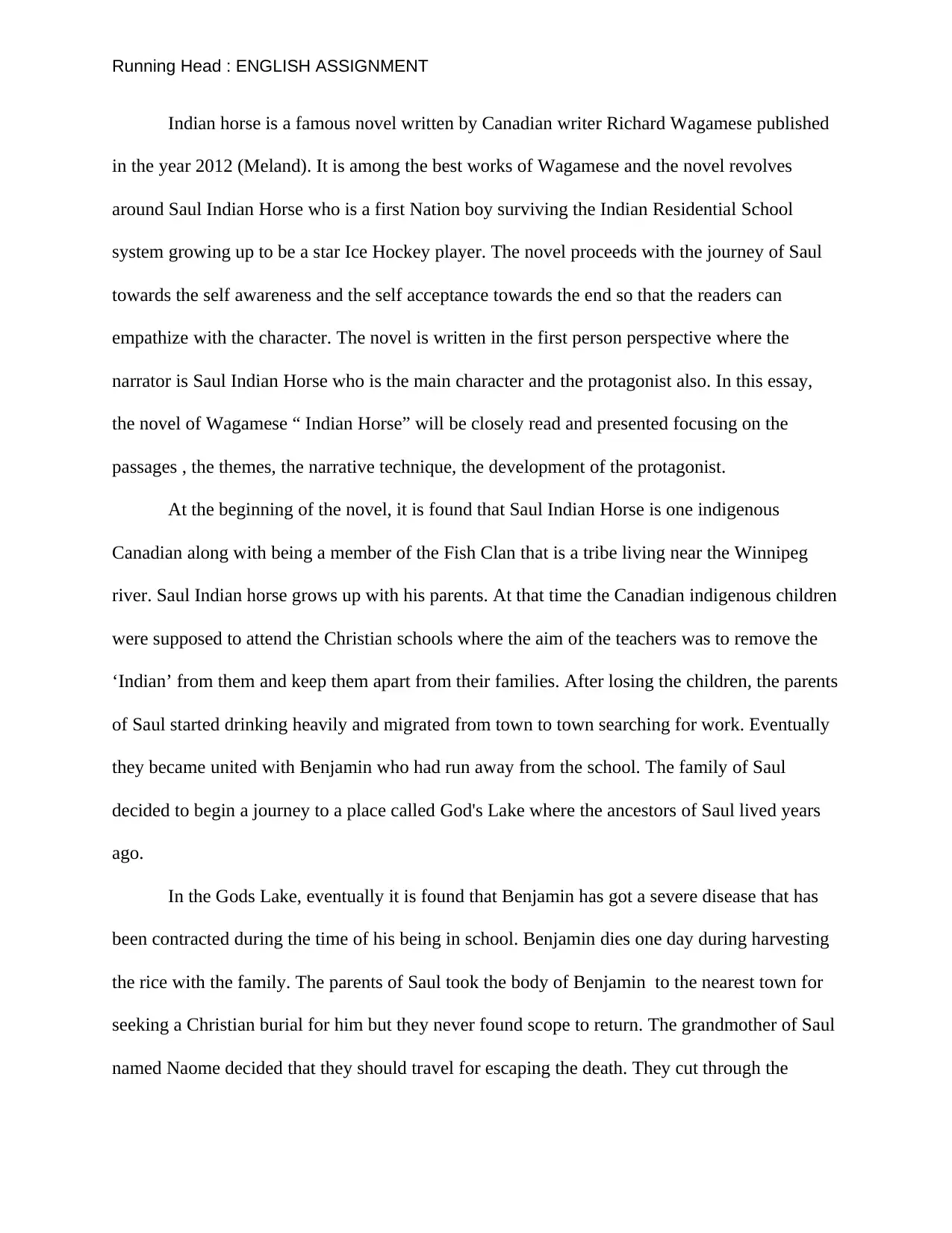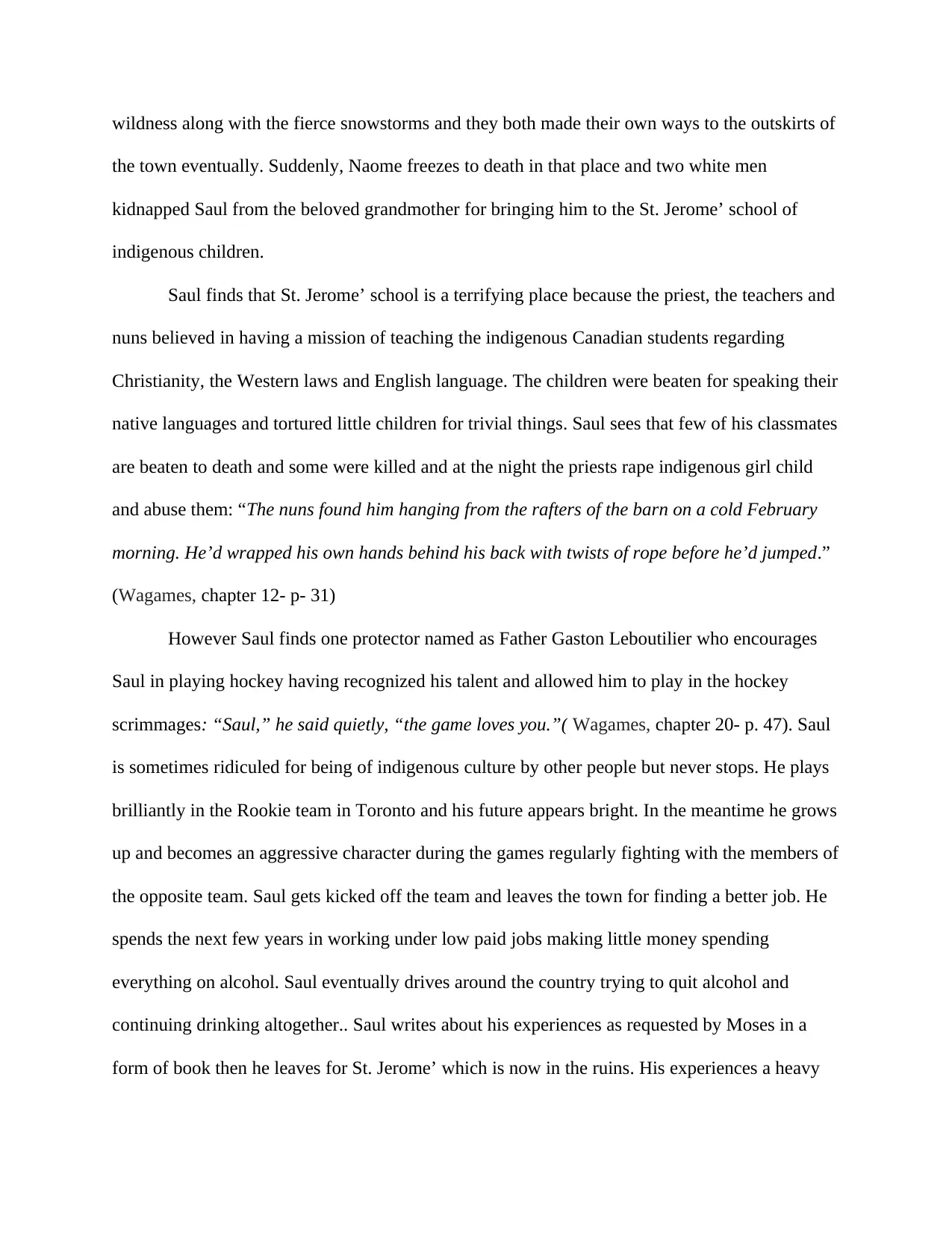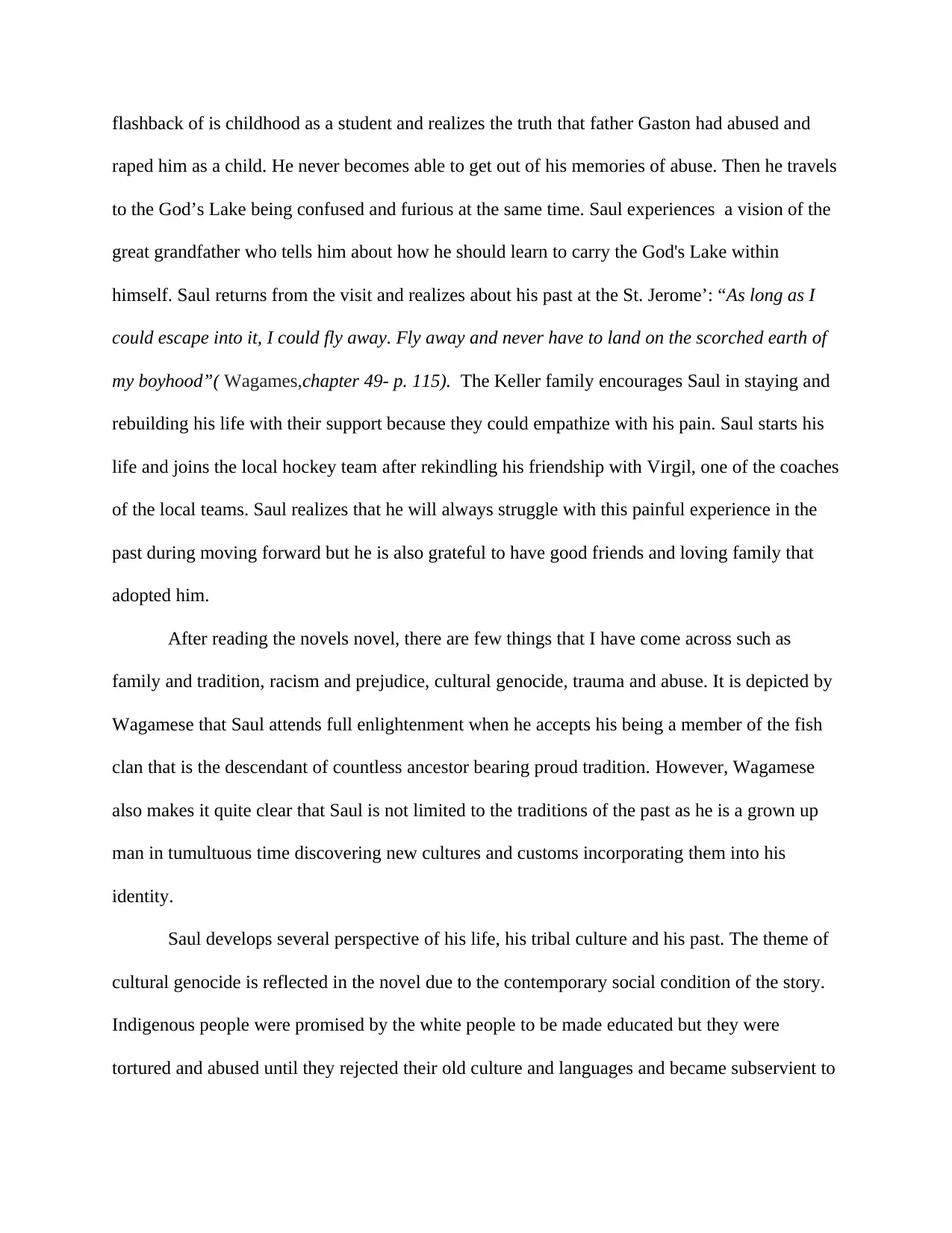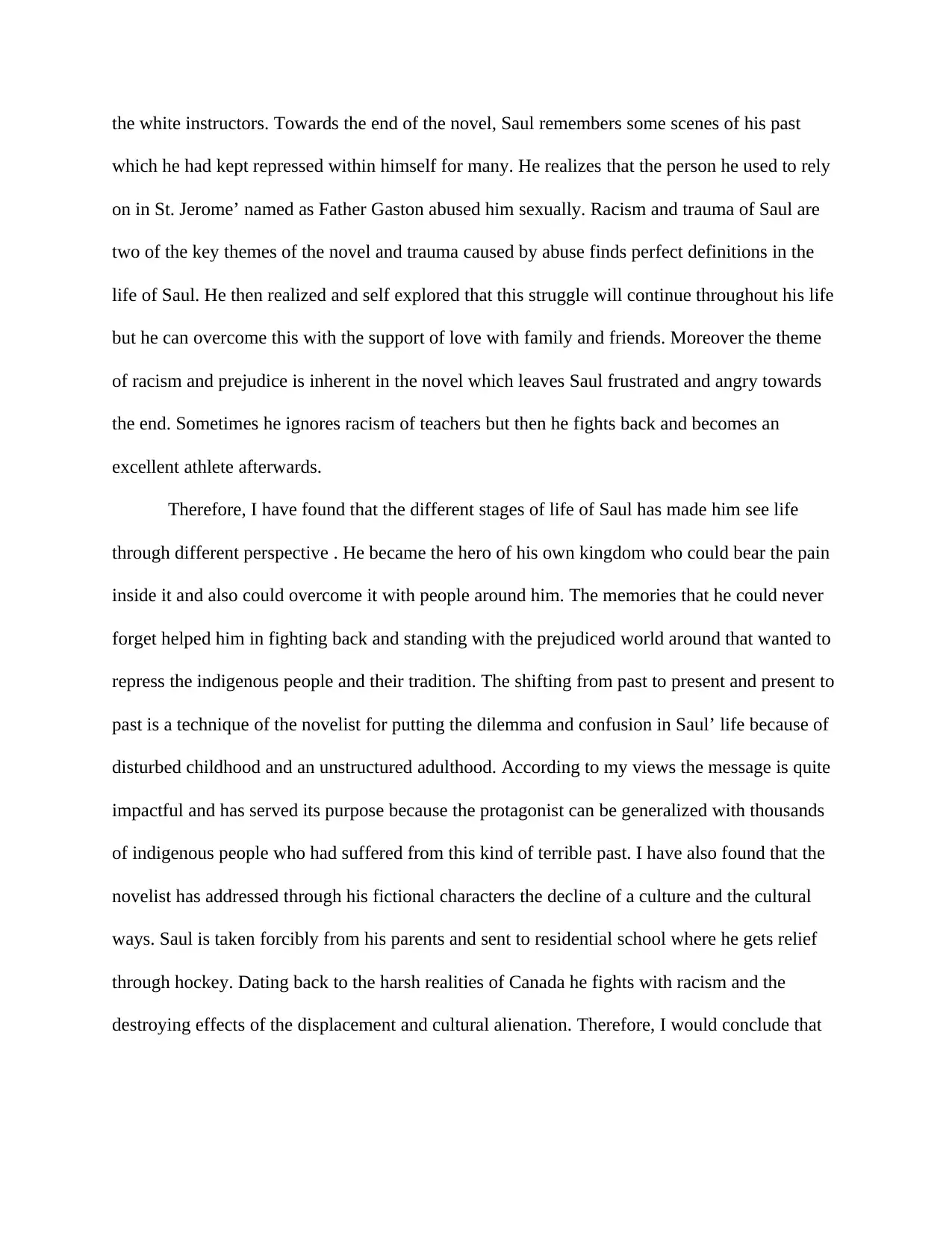Analyzing Trauma, Identity, and Culture in Indian Horse
VerifiedAdded on 2022/09/09
|5
|1578
|31
Essay
AI Summary
This essay provides a detailed analysis of Richard Wagamese's novel, "Indian Horse," focusing on the protagonist, Saul Indian Horse, and his experiences within the context of the Canadian residential school system. The essay explores key themes such as family and tradition, racism and prejudice, cultural genocide, and the lasting impact of trauma and abuse. It examines the narrative techniques used by Wagamese, including the first-person perspective and the shifting between past and present, to portray Saul's journey of self-discovery and acceptance. The essay highlights how Saul's experiences with hockey, abuse, and cultural identity shape his character and his struggle to reconcile his past with his present, ultimately emphasizing the resilience of the human spirit in the face of adversity and the importance of cultural understanding. The essay references the novel's plot points and the protagonist's emotional and psychological development to illustrate the core themes of the novel and the impact of the residential school system on Indigenous peoples.

Running Head : ENGLISH ASSIGNMENT
Indian horse is a famous novel written by Canadian writer Richard Wagamese published
in the year 2012 (Meland). It is among the best works of Wagamese and the novel revolves
around Saul Indian Horse who is a first Nation boy surviving the Indian Residential School
system growing up to be a star Ice Hockey player. The novel proceeds with the journey of Saul
towards the self awareness and the self acceptance towards the end so that the readers can
empathize with the character. The novel is written in the first person perspective where the
narrator is Saul Indian Horse who is the main character and the protagonist also. In this essay,
the novel of Wagamese “ Indian Horse” will be closely read and presented focusing on the
passages , the themes, the narrative technique, the development of the protagonist.
At the beginning of the novel, it is found that Saul Indian Horse is one indigenous
Canadian along with being a member of the Fish Clan that is a tribe living near the Winnipeg
river. Saul Indian horse grows up with his parents. At that time the Canadian indigenous children
were supposed to attend the Christian schools where the aim of the teachers was to remove the
‘Indian’ from them and keep them apart from their families. After losing the children, the parents
of Saul started drinking heavily and migrated from town to town searching for work. Eventually
they became united with Benjamin who had run away from the school. The family of Saul
decided to begin a journey to a place called God's Lake where the ancestors of Saul lived years
ago.
In the Gods Lake, eventually it is found that Benjamin has got a severe disease that has
been contracted during the time of his being in school. Benjamin dies one day during harvesting
the rice with the family. The parents of Saul took the body of Benjamin to the nearest town for
seeking a Christian burial for him but they never found scope to return. The grandmother of Saul
named Naome decided that they should travel for escaping the death. They cut through the
Indian horse is a famous novel written by Canadian writer Richard Wagamese published
in the year 2012 (Meland). It is among the best works of Wagamese and the novel revolves
around Saul Indian Horse who is a first Nation boy surviving the Indian Residential School
system growing up to be a star Ice Hockey player. The novel proceeds with the journey of Saul
towards the self awareness and the self acceptance towards the end so that the readers can
empathize with the character. The novel is written in the first person perspective where the
narrator is Saul Indian Horse who is the main character and the protagonist also. In this essay,
the novel of Wagamese “ Indian Horse” will be closely read and presented focusing on the
passages , the themes, the narrative technique, the development of the protagonist.
At the beginning of the novel, it is found that Saul Indian Horse is one indigenous
Canadian along with being a member of the Fish Clan that is a tribe living near the Winnipeg
river. Saul Indian horse grows up with his parents. At that time the Canadian indigenous children
were supposed to attend the Christian schools where the aim of the teachers was to remove the
‘Indian’ from them and keep them apart from their families. After losing the children, the parents
of Saul started drinking heavily and migrated from town to town searching for work. Eventually
they became united with Benjamin who had run away from the school. The family of Saul
decided to begin a journey to a place called God's Lake where the ancestors of Saul lived years
ago.
In the Gods Lake, eventually it is found that Benjamin has got a severe disease that has
been contracted during the time of his being in school. Benjamin dies one day during harvesting
the rice with the family. The parents of Saul took the body of Benjamin to the nearest town for
seeking a Christian burial for him but they never found scope to return. The grandmother of Saul
named Naome decided that they should travel for escaping the death. They cut through the
Paraphrase This Document
Need a fresh take? Get an instant paraphrase of this document with our AI Paraphraser

wildness along with the fierce snowstorms and they both made their own ways to the outskirts of
the town eventually. Suddenly, Naome freezes to death in that place and two white men
kidnapped Saul from the beloved grandmother for bringing him to the St. Jerome’ school of
indigenous children.
Saul finds that St. Jerome’ school is a terrifying place because the priest, the teachers and
nuns believed in having a mission of teaching the indigenous Canadian students regarding
Christianity, the Western laws and English language. The children were beaten for speaking their
native languages and tortured little children for trivial things. Saul sees that few of his classmates
are beaten to death and some were killed and at the night the priests rape indigenous girl child
and abuse them: “The nuns found him hanging from the rafters of the barn on a cold February
morning. He’d wrapped his own hands behind his back with twists of rope before he’d jumped.”
(Wagames, chapter 12- p- 31)
However Saul finds one protector named as Father Gaston Leboutilier who encourages
Saul in playing hockey having recognized his talent and allowed him to play in the hockey
scrimmages: “Saul,” he said quietly, “the game loves you.”( Wagames, chapter 20- p. 47). Saul
is sometimes ridiculed for being of indigenous culture by other people but never stops. He plays
brilliantly in the Rookie team in Toronto and his future appears bright. In the meantime he grows
up and becomes an aggressive character during the games regularly fighting with the members of
the opposite team. Saul gets kicked off the team and leaves the town for finding a better job. He
spends the next few years in working under low paid jobs making little money spending
everything on alcohol. Saul eventually drives around the country trying to quit alcohol and
continuing drinking altogether.. Saul writes about his experiences as requested by Moses in a
form of book then he leaves for St. Jerome’ which is now in the ruins. His experiences a heavy
the town eventually. Suddenly, Naome freezes to death in that place and two white men
kidnapped Saul from the beloved grandmother for bringing him to the St. Jerome’ school of
indigenous children.
Saul finds that St. Jerome’ school is a terrifying place because the priest, the teachers and
nuns believed in having a mission of teaching the indigenous Canadian students regarding
Christianity, the Western laws and English language. The children were beaten for speaking their
native languages and tortured little children for trivial things. Saul sees that few of his classmates
are beaten to death and some were killed and at the night the priests rape indigenous girl child
and abuse them: “The nuns found him hanging from the rafters of the barn on a cold February
morning. He’d wrapped his own hands behind his back with twists of rope before he’d jumped.”
(Wagames, chapter 12- p- 31)
However Saul finds one protector named as Father Gaston Leboutilier who encourages
Saul in playing hockey having recognized his talent and allowed him to play in the hockey
scrimmages: “Saul,” he said quietly, “the game loves you.”( Wagames, chapter 20- p. 47). Saul
is sometimes ridiculed for being of indigenous culture by other people but never stops. He plays
brilliantly in the Rookie team in Toronto and his future appears bright. In the meantime he grows
up and becomes an aggressive character during the games regularly fighting with the members of
the opposite team. Saul gets kicked off the team and leaves the town for finding a better job. He
spends the next few years in working under low paid jobs making little money spending
everything on alcohol. Saul eventually drives around the country trying to quit alcohol and
continuing drinking altogether.. Saul writes about his experiences as requested by Moses in a
form of book then he leaves for St. Jerome’ which is now in the ruins. His experiences a heavy

flashback of is childhood as a student and realizes the truth that father Gaston had abused and
raped him as a child. He never becomes able to get out of his memories of abuse. Then he travels
to the God’s Lake being confused and furious at the same time. Saul experiences a vision of the
great grandfather who tells him about how he should learn to carry the God's Lake within
himself. Saul returns from the visit and realizes about his past at the St. Jerome’: “As long as I
could escape into it, I could fly away. Fly away and never have to land on the scorched earth of
my boyhood”( Wagames,chapter 49- p. 115). The Keller family encourages Saul in staying and
rebuilding his life with their support because they could empathize with his pain. Saul starts his
life and joins the local hockey team after rekindling his friendship with Virgil, one of the coaches
of the local teams. Saul realizes that he will always struggle with this painful experience in the
past during moving forward but he is also grateful to have good friends and loving family that
adopted him.
After reading the novels novel, there are few things that I have come across such as
family and tradition, racism and prejudice, cultural genocide, trauma and abuse. It is depicted by
Wagamese that Saul attends full enlightenment when he accepts his being a member of the fish
clan that is the descendant of countless ancestor bearing proud tradition. However, Wagamese
also makes it quite clear that Saul is not limited to the traditions of the past as he is a grown up
man in tumultuous time discovering new cultures and customs incorporating them into his
identity.
Saul develops several perspective of his life, his tribal culture and his past. The theme of
cultural genocide is reflected in the novel due to the contemporary social condition of the story.
Indigenous people were promised by the white people to be made educated but they were
tortured and abused until they rejected their old culture and languages and became subservient to
raped him as a child. He never becomes able to get out of his memories of abuse. Then he travels
to the God’s Lake being confused and furious at the same time. Saul experiences a vision of the
great grandfather who tells him about how he should learn to carry the God's Lake within
himself. Saul returns from the visit and realizes about his past at the St. Jerome’: “As long as I
could escape into it, I could fly away. Fly away and never have to land on the scorched earth of
my boyhood”( Wagames,chapter 49- p. 115). The Keller family encourages Saul in staying and
rebuilding his life with their support because they could empathize with his pain. Saul starts his
life and joins the local hockey team after rekindling his friendship with Virgil, one of the coaches
of the local teams. Saul realizes that he will always struggle with this painful experience in the
past during moving forward but he is also grateful to have good friends and loving family that
adopted him.
After reading the novels novel, there are few things that I have come across such as
family and tradition, racism and prejudice, cultural genocide, trauma and abuse. It is depicted by
Wagamese that Saul attends full enlightenment when he accepts his being a member of the fish
clan that is the descendant of countless ancestor bearing proud tradition. However, Wagamese
also makes it quite clear that Saul is not limited to the traditions of the past as he is a grown up
man in tumultuous time discovering new cultures and customs incorporating them into his
identity.
Saul develops several perspective of his life, his tribal culture and his past. The theme of
cultural genocide is reflected in the novel due to the contemporary social condition of the story.
Indigenous people were promised by the white people to be made educated but they were
tortured and abused until they rejected their old culture and languages and became subservient to
⊘ This is a preview!⊘
Do you want full access?
Subscribe today to unlock all pages.

Trusted by 1+ million students worldwide

the white instructors. Towards the end of the novel, Saul remembers some scenes of his past
which he had kept repressed within himself for many. He realizes that the person he used to rely
on in St. Jerome’ named as Father Gaston abused him sexually. Racism and trauma of Saul are
two of the key themes of the novel and trauma caused by abuse finds perfect definitions in the
life of Saul. He then realized and self explored that this struggle will continue throughout his life
but he can overcome this with the support of love with family and friends. Moreover the theme
of racism and prejudice is inherent in the novel which leaves Saul frustrated and angry towards
the end. Sometimes he ignores racism of teachers but then he fights back and becomes an
excellent athlete afterwards.
Therefore, I have found that the different stages of life of Saul has made him see life
through different perspective . He became the hero of his own kingdom who could bear the pain
inside it and also could overcome it with people around him. The memories that he could never
forget helped him in fighting back and standing with the prejudiced world around that wanted to
repress the indigenous people and their tradition. The shifting from past to present and present to
past is a technique of the novelist for putting the dilemma and confusion in Saul’ life because of
disturbed childhood and an unstructured adulthood. According to my views the message is quite
impactful and has served its purpose because the protagonist can be generalized with thousands
of indigenous people who had suffered from this kind of terrible past. I have also found that the
novelist has addressed through his fictional characters the decline of a culture and the cultural
ways. Saul is taken forcibly from his parents and sent to residential school where he gets relief
through hockey. Dating back to the harsh realities of Canada he fights with racism and the
destroying effects of the displacement and cultural alienation. Therefore, I would conclude that
which he had kept repressed within himself for many. He realizes that the person he used to rely
on in St. Jerome’ named as Father Gaston abused him sexually. Racism and trauma of Saul are
two of the key themes of the novel and trauma caused by abuse finds perfect definitions in the
life of Saul. He then realized and self explored that this struggle will continue throughout his life
but he can overcome this with the support of love with family and friends. Moreover the theme
of racism and prejudice is inherent in the novel which leaves Saul frustrated and angry towards
the end. Sometimes he ignores racism of teachers but then he fights back and becomes an
excellent athlete afterwards.
Therefore, I have found that the different stages of life of Saul has made him see life
through different perspective . He became the hero of his own kingdom who could bear the pain
inside it and also could overcome it with people around him. The memories that he could never
forget helped him in fighting back and standing with the prejudiced world around that wanted to
repress the indigenous people and their tradition. The shifting from past to present and present to
past is a technique of the novelist for putting the dilemma and confusion in Saul’ life because of
disturbed childhood and an unstructured adulthood. According to my views the message is quite
impactful and has served its purpose because the protagonist can be generalized with thousands
of indigenous people who had suffered from this kind of terrible past. I have also found that the
novelist has addressed through his fictional characters the decline of a culture and the cultural
ways. Saul is taken forcibly from his parents and sent to residential school where he gets relief
through hockey. Dating back to the harsh realities of Canada he fights with racism and the
destroying effects of the displacement and cultural alienation. Therefore, I would conclude that
Paraphrase This Document
Need a fresh take? Get an instant paraphrase of this document with our AI Paraphraser

“Indian horse” is one of the greatest works of Wagamese capturing the dark realities of
Christianization and white culture.
Christianization and white culture.
1 out of 5
Your All-in-One AI-Powered Toolkit for Academic Success.
+13062052269
info@desklib.com
Available 24*7 on WhatsApp / Email
![[object Object]](/_next/static/media/star-bottom.7253800d.svg)
Unlock your academic potential
Copyright © 2020–2025 A2Z Services. All Rights Reserved. Developed and managed by ZUCOL.
